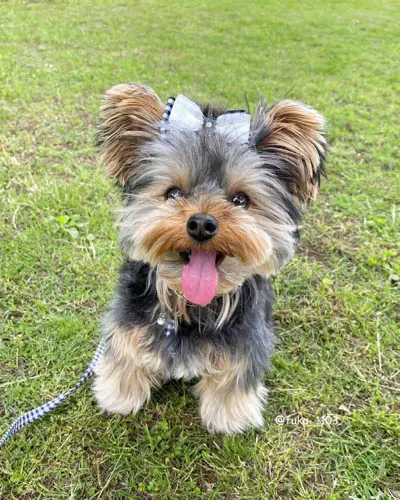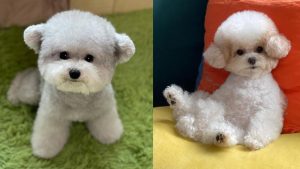Babies are bundles of joys and often bring significant changes in the house. Baby is the source of excitement and anxiety not only to the family members but also to your fur baby. As a parent of both your baby and your fur baby, you wanted that both of them to get along.
Since you cannot have your baby make the necessary adjustment to the situation, it is a must that you have to resort to ways on how you can introduce your baby to your dog.
Your fur baby may use to be pampered with love and affection before the coming of your baby. It may have been the center of your attention.
With the arrival of the baby, such pampering, concentration, and love may be shifted to the baby. Such emotional shifts may cause some emotional strain and anxieties to your dog. To have a smooth relationship between the baby and the dog, you must undertake specific measures to do it.
Here are the 16 tips on which you can heed to introduce your baby to your dog. You may opt to use any of these tips based on the surrounding circumstances that you have.
1. Familiarization of your dog to a new sound, sight, and smell.

Mental and emotional conditioning is the key to having your dog prepared for the expected changes in the house. Before the arrival of the baby, you need to let your dog be accustomed to “baby sounds” like crying and cooing.
You can also prepare the dog’s sense of smell by putting on some baby lotion to your body for it to be familiar with the baby’s scent.
Carrying a baby doll around and a baby stroller will condition the dog to the sight of having a baby being carried and being put in the stroller. So that once you are already holding the “real” baby, the dog will not react differently.
2. Let other babies surround the dog.
Strange things may arouse and cause alarm, excitement, fear, apprehension, and anxiety. This is true with your dog when your fur baby is confronted with something unfamiliar.
To avoid that “shocking” scenario, it is better to have your dog be accustomed to being surrounded by kids and babies. Before the baby’s coming into the house, have your nieces, nephews, and neighbor kids stay and play in your house. Eventually, the dog will be at ease with the giggling, laughing, the noise of those hyperactive toddlers.
You can also have your dog be exposed to babies and kids at the public parks. Exposure to the “little angels” will make your dog comfortable with the presence of babies and kids.
3. Reduce the level of activity.

If there is something common with dogs and kids is their level of hyperactivity. Your dog has a zest for activities, and it will be better if you will tone down some activities before the baby’s coming to the house.
Reduce some playful activities so that the dog is already conditioned for reduced attention and may no longer long for it once you have your baby inside the house.
4. Train your dog to keep out from certain rooms.
Spoiling a fur baby does not connote that it should not be taught certain boundaries. It is better that you have your dog trained not to enter certain rooms like the baby’s room, bedroom, or other rooms used by the baby.
When properly trained, the dog will not enter the room of which it is being refrained from entering. Such training will be advantageous once you have your “cutie baby” in your house, for the dog will not just enter your baby’s room that may cause alarm and another untoward incident. However, despite that training, you must still monitor your dog’s mobility.
5. Exhaust your dog’s energy.
The most crucial time is the first day on which you are going to bring home your baby. Proper tactics must be utilized, especially with your dog, to have a smooth “first-day” meeting.
Before the coming of the baby, have your dog play outside or be accompanied by a dog walker so that its level of energy has been waned and exhausted. In this way, when you got back home with the baby, the dog is in a good mood, and the level of energy is already low.
The “first meeting” will turn out to be pleasant both to your baby and with your dog. The adage says that the first impression leaves a lasting mark, so it is better to make sure that the first meeting is positive and pleasant.
6. Gradually introduce your dog to your baby.

Everything has its perfect time, and do not rush things for everything will fall in the right places in due time. Interaction between your dog and the baby should not immediately be made, especially when you can sense that the dog is not yet ready.
Same with human beings, the dog must also be emotionally, physically, and mentally prepared to meet the new member of the family. Have the dog familiarize with the presence of the baby inside the house.
Every day’s presence of the baby will make the dog comfortable and at ease to the baby’s presence. If everything is turning to be positive and you are sure that certain boundaries have been set, and your fur baby is already accustomed to your “little angel,” then you can introduce the baby to the dog. Have the interaction be brief, and it should not be done regularly.
7. Make your dog have a brief sniff of your baby.
The best way for your dog to be acquainted with your baby is to have your dog sniff your baby. Make this moment positive by making the experience brief and shower your dog with dog treats.
8. Monitor your dog’s whereabouts.
Curiosity with the baby may trigger the dog to jump into the baby’s crib, and this is the type of scenario that you wanted to avoid.
You love both your baby and the dog, but precaution must be made, especially with your dog’s mobility. By closely monitoring its movement and its whereabouts, you will be assured as to the safety of the baby inside the nursery room.

9. Allocate time to be with your dog.
Do not just let your dog sulk and be deprived of the attention to which it is used, for it may lead to some negative emotion towards the baby. It is a given fact that having a baby around requires a lot of attention; however, you must allocate at least a few minutes to be with your dog.
Give at least ten to fifteen minutes of your time to be with your dog so that it will still feel your love and affection despite the presence of the baby.
10. Remember not to give in to the dog’s attention-seeking behavior.
Baby and dog are creatures that exhibit attention-seeking behavior, and surely it will drive you nuts if you keep on giving in to their “demanding” behavior. Learn to control your impulse and ignore your dog when it keeps on barking to get your attention.
In this way, the dog will not resort to such annoying behavior to get your attention, for the dog already understands that its tactics do not work.

11. Train your dog to maintain “eye contact” with people.
You may be wondering the importance of this type of training of establishing “eye contact” of your dog with the people it is interacting with. It is a fact that the baby and a toddler are at the dog’s eye level, and often a baby will directly look at the dog’s eyes. If the dog is not trained to maintain an eye-contact with a person, it may cause some unexpected dog response.
Make sure that the people who give you a visit establish eye contact with the dog. It is in this way that the dog will be used to staring with people’s eyeballs.
12. Make a safe distance between your dog and the baby.
Surely you love to see your baby establishing a certain “bond” with your dog, and it may be thrilling to see your dog licking your baby’s sweet “milky” taste face. Still, it should be avoided for the baby may create certain actions like crying, screaming that may create “confusion” to the dog that may lead to a certain unexpected response to the dog.
The best way is to establish a safe distance between the baby and the dog so that both of them will not be caught by any untoward behavior that may cause alarm and harm.
13. Have a keen eye on your dog’s body cues.

There may be a communication barrier between you and your dog, for your fur baby cannot verbalize its feelings and emotions, but you can understand your dog through its body cues.
Once your dog starts to lick its lips, looks away with ears back, you can already sense that your dog is troubled, and you must take precautionary measures by bringing the dog to a safe place and a bit away from the baby.
14. Refrain from punishing and scolding your dog.
There may be times that your dog will manifest certain unwanted behavior. It is better to have it ignored rather than inflict punishment on the dog.
Such punishment may create a certain “negative” association with the baby, especially if your dog is not used to being scolded and punished before the baby’s coming.
15. Make a space for your dog to hang around.

If the baby nursery is a dog-free zone, it is also better to have a place for your dog, a baby-free zone. It is a place where your dog can freely play with its toy and hang around without seeing the baby.
It will be the place of which may be the dog’s comfort zone of which it can lie around without being disturbed by the baby’s crying.
16. Have a different feeding space for the baby.
Areas and places in the house bring many fond memories to your dog, and it may associate these places with your time and affection with the dog. If you have been using the couch in cuddling and hugging your dog, it may not be a good spot for you to use it in feeding your baby.
It is better that you look for a place to feed your little one without soliciting any negativity from your dog. You can use the nursery so that your baby is comfortable during her feeding time.





